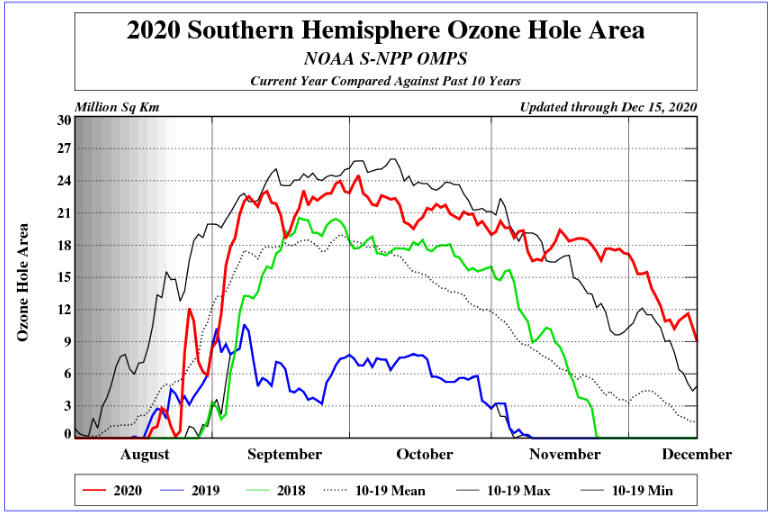
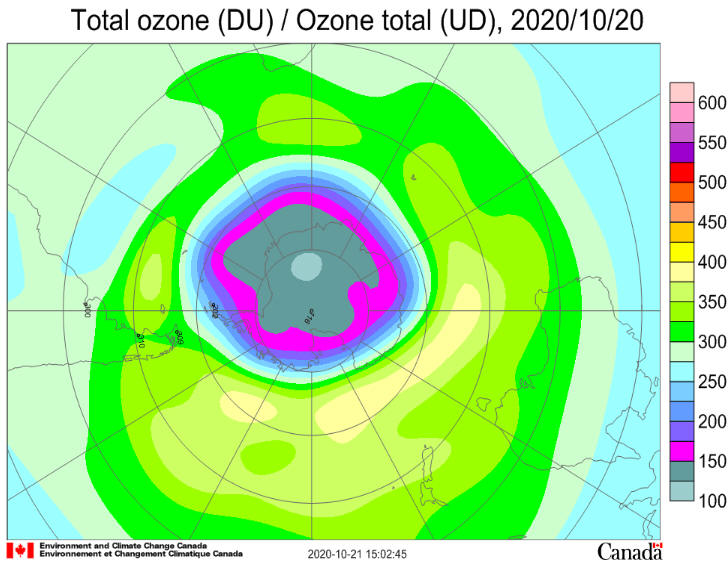
29
December 2020
WMO-The
record-breaking 2020 Antarctic ozone hole finally closed at
the end of December after an exceptional season due to
naturally occurring meteorological conditions and the
continued presence of ozone depleting substances in the
atmosphereThe 2020 ozone hole grew rapidly from
mid-August and peaked at around 24.8 million square
kilometres on 20 September 2020, spreading over most of the
Antarctic continent.
It was the longest-lasting and one of the largest and
deepest holes since the ozone layer monitoring began 40
years ago. It was driven by a strong, stable and cold polar
vortex and very cold temperatures in the stratosphere (the
layer of the atmosphere between around 10 km and round 50 km
altitude).
“The last two ozone hole seasons demonstrate the
year-to-year variability of the ozone hole and improve our
understanding of the factors responsible for its formation,
extent and severity,” said Oksana Tarasova, head of WMO
Atmospheric Environment Research Division, which oversees
WMO Global Atmosphere Watch network of monitoring stations.
“We need continued international action to enforce the
Montreal Protocol on ozone depleting chemicals. There is
still enough ozone depleting substances in the atmosphere to
cause ozone depletion on an annual basis,” said Dr Tarasova.
WMO’s Global Atmosphere Watch programme works closely with
Copernicus Atmospheric Monitoring Service, NASA, Environment
and Climate Change Canada and other partners to monitor the
Earth’s ozone layer, which protects us from the harmful
ultraviolet rays of the sun. Strong Polar Vortex Ozone
depletion is directly related to the temperature in the
stratosphere, which is the layer of the atmosphere between
around 10 km and round 50 km altitude. This is because polar
stratospheric clouds, which have an important role in the
chemical destruction of ozone, only form at temperatures
below -78°C. These polar stratospheric clouds contain ice
crystals that can turn non-reactive compounds into reactive
ones, which can then rapidly destroy ozone as soon as light
from the sun becomes available to start the chemical
reactions. This dependency on polar stratospheric clouds and
solar radiation is the main reason the ozone hole is only
seen in late winter/early spring.
During the Southern Hemisphere spring season (August -
October) the ozone hole over the Antarctic increases in
size, reaching a maximum between mid-September and
mid-October (NASA Ozone Watch image of 2020 ozone hole at
its September peak pictured left). When temperatures high up
in the atmosphere (stratosphere) start to rise in late
Southern Hemisphere spring, ozone depletion slows, the polar
vortex weakens and finally breaks down, and by the end of
December ozone levels have returned to normal. However, in
2020, a strong, stable and cold polar vortex kept the
temperature of the ozone layer over Antarctica consistently
cold, preventing the mixing of ozone depleted air above
Antarctica with ozone rich air from higher latitudes. For
much of the 2020 season, stratospheric ozone concentrations
around 20 to 25 km of altitude (50-100hPa) reached near-zero
values with the ozone layer depth as low as 94 Dobson Units
(a unit of measurement), or approximately one third of its
normal value. The EU Copernicus Atmospheric Monitoring
Service reported that ozone analyses showed the ozone hole
had closed on 28 December. Every season, the appearance of
the ozone hole and its evolution is monitored by means of
satellites and a number of ground-based observing stations.
Characteristics of the ozone hole, interactive maps,
timeseries, current state and forecast are being prepared
and monitored by the large ozone community through the
services of different organizations such as the Copernicus
Atmosphere Monitoring Service (CAMS),
NASA ozonewatch programme, NOAA,
KNMI,
ECCC and
others.
Record-breaking 2020 ozone hole closes | World
Meteorological Organization (wmo.int)
|

Depth of the 2020 ozone hole. The 2020 ozone hole is also
one of the deepest. Measurements from the Copernicus
Sentinel-5P satellite show that this year’s ozone hole has
reached its maximum depth with a peak of around 100 DU on
October 2. Credit: Contains modified Copernicus Sentinel
data (2020), processed by DLR/BIRA/ESA

Depth of the 2020 ozone hole. The 2020 ozone hole is also
one of the deepest. Measurements from the Copernicus
Sentinel-5P satellite show that this year’s ozone hole has
reached its maximum depth with a peak of around 100 DU on
October 2. Credit: Contains modified Copernicus Sentinel
data (2020), processed by DLR/BIRA/ESA |
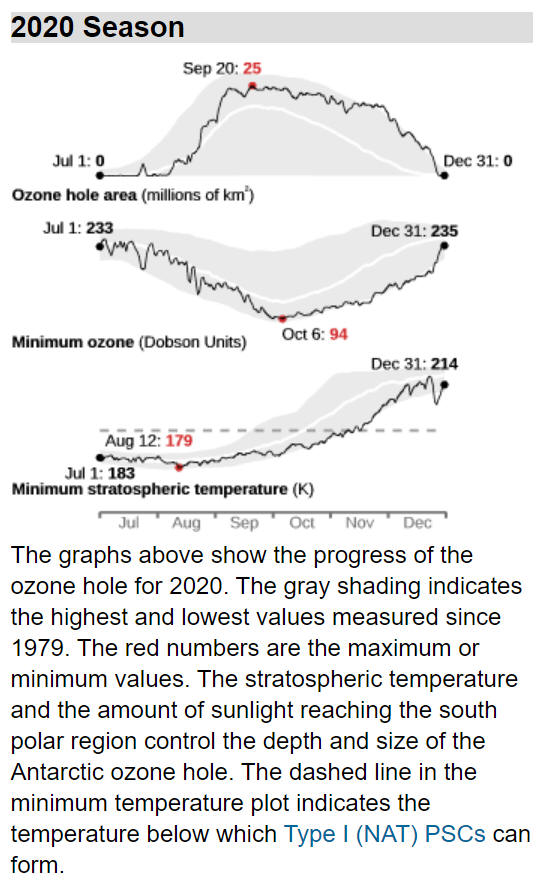 |
https://ozonewatch.gsfc.nasa.gov
Antarctic
ozone today: The 2020 ozone hole grew rapidly from mid August
and peaked at around 25 million square kilometres (msqkm) in early
October. It is shrinking very slowly and still covers 17
msqkm, by far the largest for this time of year over the last decade
and still covers much of the Antarctic continent. Ozone
amounts are generally high around the continent as the polar vortex
blocks transport further south, and are past their minimum within
the vortex. Values range from around 150 DU within the
vortex to around 360 DU outside it. NASA Ozone Watch reports a
lowest value of 94 DU recorded on October 6, the lowest for around
15 years. The vortex area near the base of the ozone layer has
passed its maximum size of around 33 msqkm in August, and has shrunk
a little to 27 msqkm which is well above average for the time of
year and close to its largest ever. It remains very stable.
The temperature of the ozone layer over Antarctica has passed its
minimum and is above the -78°C
Polar Stratospheric Cloud (PSC) formation threshold in all parts of
the ozone layer. The area with potential PSCs peaked at around 29
msqkm in July and had declined to around 0 msqkm by late November,
reaching this point later in the year than for over a decade. The
temperature within the vortex is well below average values and is
setting extreme minima for the period over the last forty years.
It is highest around Antarctica and declines towards the equator and
over the Pole. The ozone hole is expected to persist, although
slowly filling, over the coming ten days, but is nearing its end.
The Antarctic Peninsula will be mostly within the ozone hole over
the next week, but the final remnant of the hole is likely to be
expelled towards South Africa. The margins of the ozone hole
are likely to be over the tip of South America over the next few
days, with the Falkland Islands and South Georgia also affected for
most of the period.
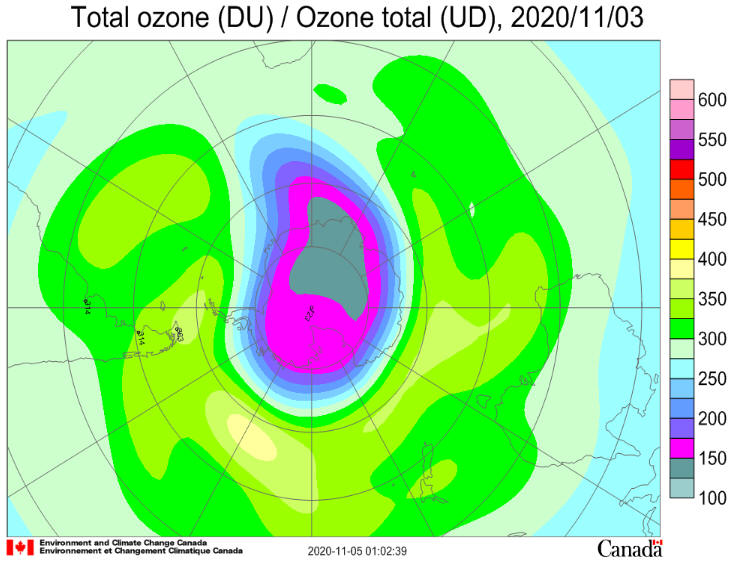
Antarctic
ozone today: The 2020 ozone hole grew rapidly from mid August
and peaked at around 25 million square kilometres (msqkm) in early
October. It now covers 19 msqkm, above average for the last
decade and covers most of the Antarctic continent. Ozone
amounts are generally high around the continent as the polar vortex
blocks transport further south, and are past their minimum within
the vortex. Values range from around 130 DU within the
vortex to nearly 400 DU outside it. The broad area with lowest
values is currently roughly near the Pole. NASA Ozone Watch
reports a lowest value of 94 DU recorded on October 6, the lowest
for around 15 years. The vortex area near the base of the
ozone layer has passed its maximum size at around 33 msqkm, and has
shrunk a little to 30 msqkm which is above average for the time of
year. It remains very stable. The temperature of the
ozone layer over Antarctica has passed its minimum but is below the -78°C
Polar Stratospheric Cloud (PSC) formation threshold in the lower
parts of the ozone layer. The area with potential PSCs peaked at
around 29 msqkm in July and has declined to around 7 msqkm, the
largest it has been at this time of year. The
temperature is below average values and is highest around Antarctica
and declines towards the equator and over the Pole. The ozone
hole is expected to persist over the coming ten days, with the
Antarctic Peninsula generally being outside the ozone hole.
November 2, 2020 NASA
Ozone Watch
Persistent cold temperatures and strong circumpolar winds supported
the formation of a large and deep Antarctic ozone hole in 2020, and
it is likely to persist into November, NOAA and NASA scientists
reported.
On September 20, 2020, the annual ozone hole reached its peak area
at 24.8 million square kilometers (9.6 million square miles),
roughly three times the size of the continental United States.
Scientists also detected the near-complete elimination of ozone for
several weeks in a 6-kilometer (4-mile) high column of the
stratosphere near the geographic South Pole.
This year brought the 12th-largest ozone hole (by area) in 40 years
of satellite records, with the 14th-lowest ozone readings in 33
years of balloon-borne instrumental measurements. However,
scientists noted that ongoing declines in the atmospheric
concentration of ozone-depleting chemicals (which are controlled by
the Montreal
Protocol) prevented the hole from being as large as it might
have been under the same weather conditions 20 years ago.
“From the year 2000 peak, Antarctic stratosphere chlorine and
bromine levels have fallen about 16 percent towards the natural
level,” said Paul Newman, an ozone layer expert and the chief Earth
scientist at NASA’s Goddard Space Flight Center. “We have a long way
to go, but that improvement made a big difference this year. The
hole would have been about a million square miles larger if there
was still as much chlorine in the stratosphere as there was in
2000.”
This year represented a dramatic turnabout from 2019, when warm
temperatures in the stratosphere and a weak polar
vortex hampered the formation of polar stratospheric clouds
(PSCs). The particles in PSCs activate forms of chlorine and bromine
compounds that destroy ozone. Last
year’s ozone hole was the smallest since the early 1980s,
growing to 16.4 million square kilometers (6.3 million square miles)
in early September.
“This clear contrast between last year and this year shows how
meteorology affects the size of the ozone hole,” said Susan Strahan,
a scientist with NASA Goddard and Universities Space Research
Association. “It also complicates detection of long-term trends.”
Atmospheric levels of ozone-depleting substances increased up to the
year 2000. Since then, they have slowly declined but remain high
enough to produce significant seasonal ozone losses. During recent
years with normal weather conditions, the ozone hole has typically
grown to a maximum of 20 million square kilometers (8 million square
miles).
In addition to the area of the ozone hole, scientists also track the
average amount of ozone depletion—how little is left inside the
hole. On October 1, 2020, weather balloons launched from NOAA’s South
Pole atmospheric observatory recorded a low value of 104 Dobson
units of atmospheric ozone. NASA’s Ozone Watch reported a lowest
daily value at 94 Dobson Units on October 6. Prior to the emergence
of the Antarctic ozone hole in the 1970s, the average amount of
ozone above the South Pole in September and October ranged from 250
to 350 Dobson units.
The amount of ozone between 13 to 21 kilometers (8 to 13 miles) in
altitude, as measured over the South Pole, has been close to record
lows at several points this year. “It’s about as close to zero as we
can measure,” said Bryan Johnson, a scientist with NOAA’s Global
Monitoring Laboratory. Still, the rate at which ozone declined in
September was slower compared with 20 years ago, which is consistent
with there being less chlorine in the atmosphere.
NASA Earth Observatory image by Joshua
Stevens, using data courtesy of NASA
Ozone Watch and GEOS-5 data from the Global
Modeling and Assimilation Office at NASA GSFC. Story by Theo
Stein, NOAA, and Ellen Gray, NASA Earth Science News Team, with EO
Staff.
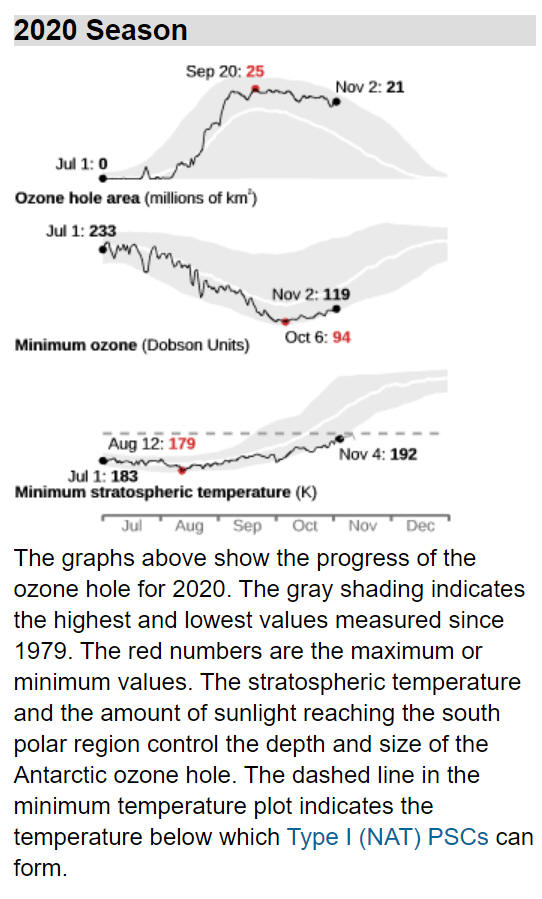
https://ozonewatch.gsfc.nasa.gov
Large, deep Antarctic ozone hole to persist into November
October 30, 2020
NOAA
Persistent cold temperatures and strong circumpolar winds supported
the formation of a large and deep Antarctic ozone hole that will
persist into November, NOAA and NASA scientists reported today.
The ozone hole reached its peak size at about 9.6 million square
miles (or 24.8 million square kilometers), roughly three times the
area of the continental United States, on September 20. Observations
revealed the nearly complete elimination of ozone in a
four-mile-high column of the stratosphere over the South Pole.
This year will go down as having the 12th-largest ozone hole in 40
years of satellite records, with the 14th-lowest ozone readings in
33 years of balloon-borne instrumental measurements, the scientists
said. Declining levels of ozone-depleting chemicals controlled by
the Montreal Protocol prevented the hole from being as large as it
would have been 20 years ago.
"We have a long way to go, but that
improvement made a big difference this year,” said Paul A. Newman,
chief scientist for Earth Sciences at NASA's Goddard Space Flight
Center. “The hole would have been about a million square miles
larger if there was still as much chlorine in the stratosphere as
there was in 2000.”
What is ozone and why does it matter?
Ozone, composed of three oxygen atoms, is highly reactive with other
chemicals. In the stratosphere, roughly 7 to 25 miles above Earth’s
surface, the ozone layer acts like sunscreen, shielding the planet
from ultraviolet radiation. Closer to Earth’s surface, ozone created
by photochemical reactions between the sun and pollution from
vehicle emissions and other sources can form harmful smog in the
lower atmosphere.
This year represented a dramatic turnabout
from 2019, when warm temperatures in the stratosphere and
a weak polar vortex limited ozone hole growth to 6.3 million square
miles (16. 4 million square kilometers), the smallest on record.
How do NOAA and NASA measure ozone?
NASA and NOAA monitor the ozone hole by using three complementary
instrumental methods.
Satellites, including NASA’s Aura satellite and NASA-NOAA Suomi
National Polar-orbiting Partnership satellite, measure the size of
the ozone hole from space. The Aura satellite’s Microwave Limb
Sounder estimates levels of ozone-destroying chlorine.
NOAA staff at the South Pole also launch weather balloons carrying ozone-measuring
sondes that directly sample ozone levels vertically
through the atmosphere. Once sunshine returns after the long polar
night, with a ground-based instrument called a Dobson
spectrophotometer.
Bryan Johnson, a scientist with NOAA’s Global Monitoring Lab, said
ozonesonde measurements recorded a low daily value of 104 Dobson
units on October 1. In late October, ozone levels between 8 and 13
miles in altitude were still “about as close to zero as we can
measure.” A Dobson unit is the standard measurement for the total
amount of ozone in the atmosphere above a point on Earth's
surface.
The amount of ozone in the atmosphere is exceedingly small. Prior to
the emergence of the ozone hole in the 1970s, the average amount of
ozone above the South Pole in September and October ranged from 250
to 350 Dobson units. If 300 Dobson units of ozone were compressed
into a layer of pure ozone, it would approximate the thickness of
two pennies stacked one on top of the other.

Antarctic
ozone today: The 2020 ozone hole grew rapidly from mid August
and peaked at around 25 million square kilometres (msqkm) in early
October. It now covers 22 msqkm, above average for the last
decade and covers most of the Antarctic continent. Ozone
amounts are generally high around the continent as the polar vortex
blocks transport further south, and are past their minimum within
the vortex. Values range from around 110 DU within the
vortex to over 400 DU outside it. The area with lowest values
is currently a little offset from the Pole towards South Africa.
NASA Ozone Watch reports a lowest value of 94 DU recorded on October
6, the lowest for around 15 years. The vortex area near the
base of the ozone layer has passed its maximum size at around 33
msqkm, and has shrunk a little to 31 msqkm which is above average
for the time of year. It remains very stable. The
temperature of the ozone layer over Antarctica has passed its
minimum but is below the -78°C
Polar Stratospheric Cloud (PSC) formation threshold in the lower
parts of the ozone layer. The area with potential PSCs peaked at
around 29 msqkm in July and has declined to around 13 msqkm, the
largest it has been at this time of year. The
temperature is mostly a little below average values and is highest
around Antarctica and declines towards the equator and over the
Pole. Severe ozone depletion is expected to persist over the
coming week with the northern part of the Antarctic Peninsula
largely outside the ozone hole until near the end of the month.
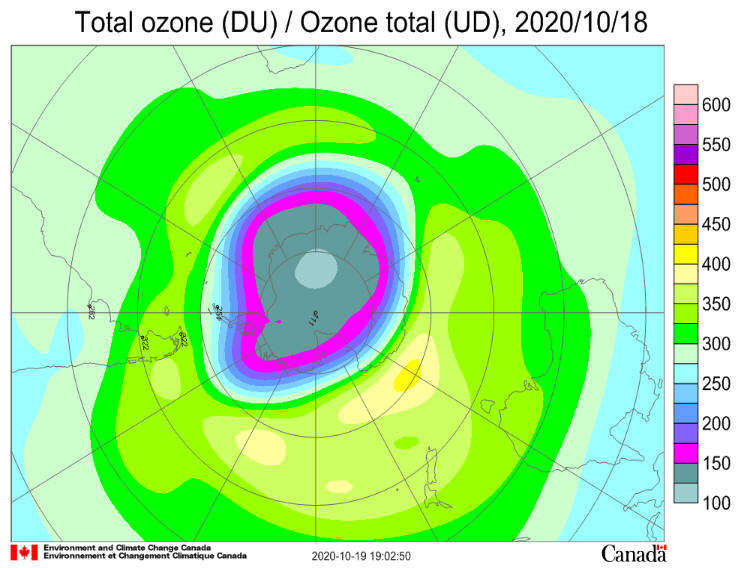
Antarctic
ozone today: The 2020 ozone hole grew rapidly from mid August
and peaked at around 24 million square kilometres (msqkm) in early
October. It now covers 22 msqkm, above average for the last
decade and covers most of the Antarctic continent. Ozone
amounts are generally high around the continent as the polar vortex
blocks transport further south, and are just past their minimum
within the vortex. Values range from around 110 DU
within the vortex to well over 400 DU outside it. The area
with lowest values is currently roughly over Dronning Maud Land.
NASA Ozone Watch reports a lowest value of 94 DU recorded on October
6, the lowest for around 15 years. The vortex area near the
base of the ozone layer has passed its maximum size at around 33
msqkm, and has shrunk a little to 31 msqkm which is near average for
the time of year. It remains very stable. The
temperature of the ozone layer over Antarctica has passed its
minimum but is below the -78°C
Polar Stratospheric Cloud (PSC) formation threshold in the lower
parts of the ozone layer. The area with potential PSCs peaked at
around 29 msqkm in July and has declined to around 13 msqkm, well
above the average for the time of year. The
temperature is mostly a little below average values and is highest
around Antarctica and declines towards the equator and over the
Pole. Severe ozone depletion is expected to persist over the
coming week with the hole transiting back from being elliptical to
circular.
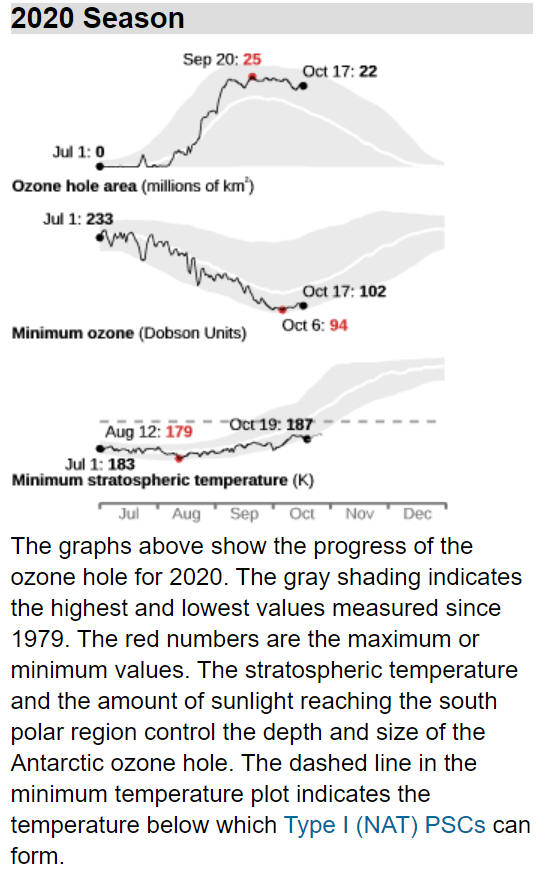
https://ozonewatch.gsfc.nasa.gov
2020 Antarctic ozone hole is large and deep
Published
6 October 2020
The
World Meteorological Organization (WMO)
The annually occurring ozone hole over the Antarctic is one of the
largest and deepest in recent years. Analyses show that the hole has
reached its maximum size.
The 2020 ozone hole grew rapidly from mid-August and peaked at
around 24 million square kilometres in early October. It now
covers 23 million km2, above average for the last decade and
spreading over most of the Antarctic continent.
WMO’s Global Atmosphere Watch programme works closely with
Copernicus Atmospheric Monitoring Service, NASA, Environment and
Climate Change Canada and other partners to monitor the Earth’s
ozone layer, which protects us from the harmful ultraviolet rays of
the sun.
NASA’s Ozone Watch reports a lowest value of 95 Dobson
Units recorded on October 1. Scientists are seeing signs that
the 2020 ozone hole now seems to have reached its maximum extent.
“There is much variability in
how far ozone hole events develop each year. The 2020 ozone hole
resembles the one from 2018, which also was a quite large hole, and
is definitely in the upper part of the pack of the last fifteen
years or so”, Vincent-Henri Peuch, Director
of Copernicus Atmosphere Monitoring Service at ECMWF,
said in a news release.
“With the sunlight returning to
the South Pole in the last weeks, we saw continued ozone depletion
over the area. After
the unusually small and short-lived ozone hole in 2019, which
was driven by special meteorological conditions, we are registering
a rather large one again this year, which confirms that we need to
continue enforcing the Montreal Protocol banning emissions of ozone
depleting chemicals.”
The Montreal Protocol bans emissions of ozone depleting chemicals.
Since the ban on halocarbons, the ozone layer has slowly been
recovering; the data clearly show a trend in decreasing area of the
ozone hole.
The latest WMO /UN Environment
Programme Scientific Assessment of Ozone Depletion, issued
in 2018, concluded that the ozone layer on the path of recovery and
to potential return of the ozone values over Antarctica to pre-1980
levels by 2060.
The large ozone hole in 2020 has beendriven by a strong, stable and
cold polar vortex, which kept the temperature of the ozone layer
over Antarctica consistently cold.
Ozone depletion is directly related to the temperature in the
stratosphere, which is the layer of the atmosphere between around 10
km and round 50 km altitude. This is because polar stratospheric
clouds, which have an important role in the chemical destruction of
ozone, only form at temperatures below -78°C.
These polar stratospheric clouds contain ice crystals that can turn
non-reactive compounds into reactive ones, which can then rapidly
destroy ozone as soon as light from the sun becomes available to
start the chemical reactions. This dependency on polar stratospheric
clouds and solar radiation is the main reason the ozone hole is only
seen in late winter/early spring.
Stratospheric ozone concentrations have been observed to have
reduced to near-zero values over Antarctica around 20 to 25 km of
altitude (50-100hPa), with the ozone layer depth coming just below
100 Dobson Units, about a third of its typical value outside of
ozone hole events.
During the Southern Hemisphere spring season (August - October) the
ozone hole over the Antarctic increases in size, reaching a maximum
between mid-September and mid-October. When temperatures high up in
the atmosphere (stratosphere) start to rise in late Southern
Hemisphere spring, ozone depletion slows, the polar vortex weakens
and finally breaks down, and by the end of December ozone levels
have returned to normal.
https://public.wmo.int/en/media/news/2020-antarctic-ozone-hole-large-and-deep
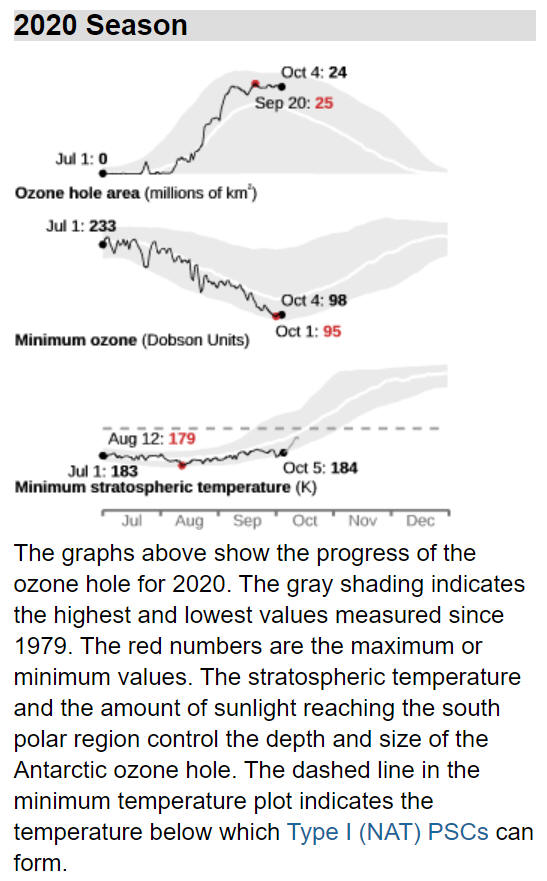
Antarctic ozone today: The 2020 ozone hole grew rapidly from mid
August and peaked at around 24 million square kilometres (msqkm) in
early October. It now covers 23 msqkm, above average for the last
decade and covers most of the Antarctic continent. Ozone amounts
are generally high around the continent as the polar vortex blocks
transport further south, and are near their minimum within the
vortex. Values range from around 100 DU within the vortex to well
over 400 DU outside it. The area with lowest values is roughly over
the polar plateau at the longitude of South Africa. NASA Ozone
Watch reports a lowest value of 95 DU recorded on October 1. The
vortex area near the base of the ozone layer has passed its maximum
size at around 33 msqkm, and has shrunk a little to 32 msqkm which
is near average for the time of year. It remains very stable. The
temperature of the ozone layer over Antarctica has passed its
minimum but is below the -78°C Polar Stratospheric Cloud (PSC)
formation threshold in most parts. The area with potential PSCs
peaked at around 29 msqkm in July and has declined to around 17
msqkm, still above the average for the time of year. The
temperature is mostly close to or a little below average values and
is highest around Antarctica and declines towards the equator and
over the Pole. Severe ozone depletion is expected to persist over
the coming week with the hole transiting from circular to
elliptical.



Antarctic
ozone today: The 2020 ozone hole has grown rapidly and now
covers 22 million square kilometres (msqkm), well above average for
the last decade. It covers most of the Antarctic continent.
Ozone amounts are generally high around the continent as the polar
vortex blocks transport further south, and are decreasing within the
vortex. Values range from around 150 DU within the
vortex to well over 400 DU outside it. Lowest values are in a
horse-shoe shaped arc. The vortex area near the base of the
ozone layer has passed its maximum size at around 33 msqkm, and has
shrunk a little to 32 msqkm which is near average for the time of
year. The temperature of the ozone layer over Antarctica is
near its minimum and is below the -78°C
Polar Stratospheric Cloud (PSC) formation threshold in most parts.
The area with potential PSCs peaked at around 29 msqkm in July and
has declined to around 21 msqkm, still a little above the average
for the time of year. The
temperature is mostly close to or a little below average values and
is highest around Antarctica and declines towards the equator and
over the Pole. Ozone depletion is expected to continue over
the coming ten days.


Antarctic
ozone today: The 2020 ozone hole has grown rapidly and now
covers 22 million square kilometres (msqkm), well above average.
It covers most of the Antarctic continent. Ozone amounts
are generally high around the continent as the polar vortex blocks
transport further south, and are decreasing within the vortex.
Values range from around 150 DU within the vortex to well over 400
DU outside it. Lowest values are over the base of the
Antarctic Peninsula. The vortex area near the base of the
ozone layer has passed its maximum size at around 33 msqkm, and has
shrunk a little to 32 msqkm which is near average for the time of
year. The temperature of the ozone layer over Antarctica is
near its minimum and is below the -78°C
Polar Stratospheric Cloud (PSC) formation threshold in most parts.
The area with potential PSCs peaked at around 29 msqkm in July and
has declined to around 21 msqkm, still a little above the average
for the time of year. The
temperature is mostly close to or a little below average values and
is highest around Antarctica and declines towards the equator and
over the Pole. Ozone depletion is expected to increase further
over the coming ten days.
Antarctic
ozone today: The 2020 ozone hole is growing. Ozone
amounts are generally building around the continent as the polar
vortex blocks transport further south, and are decreasing within the
vortex. Values range from around 190 DU within the
vortex to over 400 DU outside it. Lowest values are over West
Antarctica. Rothera experienced its first ozone hole day on
June 30. The vortex area is still slowly increasing and covers
around 33 million square kilometres (msqkm) near the base of the
ozone layer, which is above average for the time of year. The
temperature of the ozone layer over Antarctica is near its minimum
and is below the -78°C
Polar Stratospheric Cloud (PSC) formation threshold in most parts,
giving an area with potential PSC of 25 msqkm, above the average for
the time of year. The
temperature is mostly close to or a little below average values and
is highest around Antarctica and declines towards the equator and
over the Pole. Ozone depletion is expected to increase over
the coming ten days as photochemistry and planetary wave forcings
play their part.
Antarctic
ozone today: The 2020 ozone hole is growing. Ozone
amounts are generally building around the continent as the polar
vortex blocks transport further south, and are decreasing within the
vortex. Values range from around 220 DU within the
vortex to over 400 DU outside it. Lowest values are near the
Pole towards the Antarctic Peninsula. Rothera experienced its
first ozone hole day on June 30. The vortex area is increasing
and now covers around 33 million square kilometres (msqkm) near the
base of the ozone layer, which is above average for the time of
year. The temperature of the ozone layer over Antarctica is
falling and is now below the -78°C
Polar Stratospheric Cloud (PSC) formation threshold in most parts,
giving an area with potential PSC of 27 msqkm, above the average for
the time of year. The
temperature is mostly close to or a little below average values and
is highest around Antarctica and declines towards the equator and
over the Pole. Ozone depletion is expected to increase over
the coming ten days as photochemistry and planetary wave forcings
play their part.
Antarctic
ozone today: The 2020 ozone hole is growing. Ozone
amounts are generally building around the continent as the polar
vortex blocks transport further south, and are decreasing within the
vortex. Values range from around 190 DU within the
vortex to around 390 DU outside it. Lowest values are over the
Southern Ocean in the Pacfic sector. Rothera experienced its
first ozone hole day on June 30. The vortex area is increasing
and now covers around 32 million square kilometres (msqkm) near the
base of the ozone layer, which is above average for the time of
year. The temperature of the ozone layer over Antarctica is
falling and is now below the -78°C
Polar Stratospheric Cloud (PSC) formation threshold in most parts,
giving an area with potential PSC of 27 msqkm, above the average for
the time of year. The
temperature is mostly close to or a little below average values and
is highest around Antarctica and declines towards the equator and
over the Pole. Ozone depletion is expected to increase over
the coming ten days as photochemistry and planetary wave forcings
play their part.

|



















